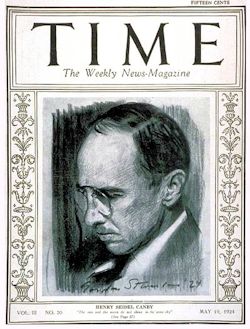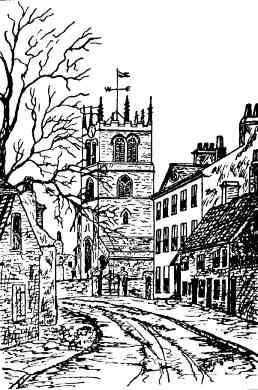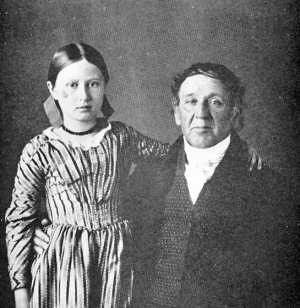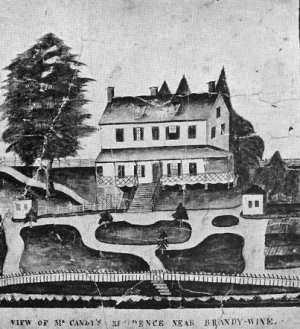Collecting Delaware Books
Henry Seidel Canby and "His" People

May 19, 1924 Time magazine cover
Henry Seidel Canby (1878-1961) left Wilmington for the halls of Yale when he was eighteen years old and never really returned. Nevertheless, he authored four books that have a place on a Delaware collectors' shelves.
Canby was born September 6, 1878, into a Quaker family that arrived in Wilmington from the area of Willow Grove, Pennsylvania, about 1740. His father and forebears were prominent in local industry and civic affairs.
When he was ten years old, Canby had a children's story published titled "Betty's Ride," a tale set at the time of the American Revolution. Though it is said to have been reprinted in anthologies several times, Collecting Delaware Books has not been able to locate a copy. As a student at Friends School in Wilmington, Henry was sent to the court house to get material for a composition on how our government is run. His exploits in the tobacco juice stained seat of justice were interesting enough to be reported by the local papers. He states, however, that what he learned was that there is a gap between reality and education — a theme he returned to often in later years.
He was too young to enter Yale when he graduated from Friends School, so he worked for a year in an electric light station. His duties left plenty of time for reading. Canby entered Yale in 1896 and earned a degree in mining engineering. His interests changed, and all his graduate work was in English, receiving his Ph.D. in 1905. He remained at Yale to teach for most of his life.
Many people have left a childhood home and settled where a career unfolded, but Canby leaves some clues to his reasons. He writes, speaking of himself, "He came to New England from his native Delaware at the tender age of eighteen. That saved him from the comfortable inertia of the spirit that has made good Republicans and honest capitalists of so many of the old stock, but infected him with zeal, the bacteria of 'Puritanism,' from which complete recovery is rare."
From 1920-1924 Canby edited the Literary Review of the New York Evening Post. In 1924, he, along with William Rose Benet and Christopher Morley, organized the Saturday Review of Literature, later called the Saturday Review, and became its first editor. This magazine was a major voice on the American literary scene for decades.
He was also chairman of the editorial board of the Book-of-the-Month Club for 28 years. This is a strange twist: Some would say the Book-of-the-Month Club was an anti-intellectual factor, in that it dictated reading tastes, second only to the Readers Digest. Saturday Review, on the other hand, went to extremes to not express judgements of taste.
His wife Marion Ponsonby Canby (nee Gause) was also a Wilmingtonian. She was a recognized poet, publishing the collections High Mowing in 1932 and On My Way in 1937.
Henry Seidel Canby died April 5, 1961, having been an important figure in American letters for over half a century.
His Books
Canby wrote or edited many books. His Walt Whitman: An American (1943), though it has been superseded as the definitive Whitman biography, is still valuable. So is his Turn West, Turn East: Mark Twain and Henry James (1951) and Thoreau (1939). Not often read today is Education by Violence (1919), an attempt to draw lessons from his World War I non-military service in England. College Sons and College Fathers (1915) exposed the gulf between students and faculty. Among his other works was The Gothic Age of the American College (1936). Many of his other books were textbooks or literary collections.
However, it is Canby's Delaware books we are interested in here.
Our House (1919)
This is his only novel, and it is set on Delaware Avenue in Wilmington, called "Millington" in the book, just before the turn of the century. The first chapter, titled "Chicken and Waffles," describes an informal evening entertainment in a wealthy Quaker home. It is said to paint an accurate picture of upper middle class life in Wilmington a century ago.
Robert Roberts is the college-age son of the host and hostess. He wants a career as a writer and is not interested in going into the business world of all the Roberts before him. His plans are disrupted by the death of his father and the discovery that his father was nearly bankrupt because of speculation in Sussex County land. The family home, the only home his mother has known in her adult life, must be sold.
Robert settles the family affairs more or less satisfactorily and returns to a life that alternates between "the crowd" in New York and the conservative world of Millington. Along the way he sells some short stories. Eventually art triumphs over commerce, and he marries the understanding girl next door, too.
This well-written story is a typical first novel. It is natural to speculate whether it is autobiographical. There are a number of parallels with Canby's life.
First, at the time Canby was in college, his father's inherited business holdings had declined. The family had to scrimp to pay college bills. The father was penniless at his death in 1912, and Henry's mother gave up her home. (His mother's fortune was partially restored when Alfred I. du Pont paid a high price for Delaware Trust Company stock to get control of a bank of his own in 1916.)
Second, dialogue in the book describes Robert Robert's search for truth and purpose in his writing. In one scene, for example, his friend echoes his thoughts, saying, "… just the race that lives between Bourgeoisie and Bohemia, to the south of Plutocracy — that's what you mean, isn't it Bob? — we sure are the only ones that count after all and nobody does [writes about] us!" And, indeed Canby did write about his own kind in all his narrative works.
Third, in the denouement, the final obstacle to marrying the girl next door is removed when Roberts swallows his Quaker and masculine pride and agrees to let her wealth support them while he establishes himself as a writer. Canby's wife Marion came from a far wealthier family than he. Although her family also suffered financial reverses early in this century, it is quite likely she brought more money to the marriage than he did.
There are many ways in which the lives of Henry Seidel Canby and Robert Roberts are unlike as well. But a careful reading will discover many interesting comparisons.
The Age of Confidence Life in the Nineties (1934)
Canby's second Wilmington book is a social history of the upper class in the 1890s. Only one chapter mentions the immigrant and black laborers and servants, many of whom still would be without electricity or indoor plumbing in their homes fifty years later. The trades people who supported and were supported by the upper class receive even less mention.
The book does describe the upper class in great detail: sex and marriage, family life, religion, politics, education, social life, outdoor activities, and reading habits. The text is mostly descriptive with relatively few anecdotes. It is easy and entertaining reading.
Writing of a dinner for family and friends, Canby says, "The table, the wine, the food, the succession of china, the exact correspondence of each course to its containers and condiments, was a ritual controlled by a flick of the eye between my mother and Robert the impeccable, and watched with devout attention by the women, who never in the utmost geniality of conversation, forgot that this supper was a ritual, nor failed in their words of praise, not too much, which would be vulgar, nor too little, for that would be unknowing."
After that sentence, worthy of Thoreau, he continues, "The men, except Uncle Billy, were grosser. Leaving consecration to their wives, they paid tribute only by a shade of careful manners to an Occasion."
The word "confidence" in the book title refers to his Wilmingtonian's conviction that their city was the best little city in the country and their state was the best little state. Their businesses were prosperous and made important contributions to the national economy. Canby's people thought that all this order was planned by some higher authority, and that it would take only a little more time to perfect society.
Canby knew that it was already a dying, or at least changing, society in 1890.
The Age of Confidence is illustrated with a number of architectural drawings by Albert Kruse, noted local architect and brother of book dealer Gertrude Kruse .
Pictures from Family History

Thorne in Yorkshire


The Brandywine (1941)
One of The Rivers of America series, The Brandywine was illustrated by the then 24-year-old Andrew Wyeth. It deals with the Brandywine River, both in Pennsylvania and Delaware.
The book describes the river's geography and geology as well as the history, industry, society, and buildings found along its banks. One chapter deals extensively with Wilmington from a "people" perspective and another with the du Ponts.
One pleasant surprise is the chapter on the literature of the Brandywine. Both the book collector and the historian will find a number of interesting titles, some of them little known. Canby even makes the case that the Sherwood Forest of Howard Pyle's The Merry Adventures of Robin Hood … "was really the noble groves and slopes of tulip, oak, chestnut, and ash along the hills and ravines and banks of the lower Brandywine."
Family History (1945)
As a book this is Canby's nicest. It is small, measuring 5� by 8� inches and 118 pages. The Riverside Press of Houghton-Mifflin published it in a printerly style, bound in red cloth with gold stamping.
Canby presents the book as if it were written for his children and descendants, yet there is no dedication. He implies it is a trifle, yet it was published by a prestigious press. He says it is not a genealogy, yet it carries his family history further back than most Americans can. Perhaps the truth is that it was another essay on his people, the upper class families of Wilmington.
Indeed, the reader will find information and anecdotes about the wealthy of Wilmington mixed with the accounts of more ancient ancestors. The Quaker industrialists seldom paid to have their families listed in the biographical volumes of state histories. It is in Family History that we learn how Canby's father was connected with Delaware Trust (see also Charles A. Silliman's 1965 The Biography of Delaware Trust Co. 1899-1965) or how his wife's family gained and lost control of a fortune in shipbuilding and steel mills.
There is also more personal information about Canby than found in his other books. We learn of long conversations with his industrialist-turned-philosopher father-in-law. The relation between his wife and mother is detailed. "Two more different women (outwardly at least) never lived, and it is to my wife's undying credit that she endured the daily lessons in a meticulous and outmoded housekeeping, far beyond our means, taking the profit, and acquiring no grievances, and somehow found her way to my mother's emotional and merry heart, and got her love, and made her happy, as few daughters-in-law could have done."
The book has no table of contents, but it is excellently indexed. Shipley, Feree, Le Fevre, Deshler, Roberts, Brandt, Seidel, Gause, Ingersoll, Gregory, and Tatnall are some of the families touched in addition to Canby.
Availablity
Family History is the scarcest of Canby's Delaware books but not difficult to find. The remaining three books are easy to find and inexpensive. Our House was widely sold throughout the United State. The Age of Confidence was also widely sold, however copies found in Delaware are more likely to be signed by the author. The Brandywine was popular locally, but the Rivers of America series has a following and is actively collected today. A copy with both the author's and the illustrator's inscription brings a premium. This book was reprinted in 1969 Schiffer Ltd., Exton, Pennsylvania.
Canby's many other books are not of special interest to the Delawareana fan, but they would make an interesting collection for someone of a literary bent.